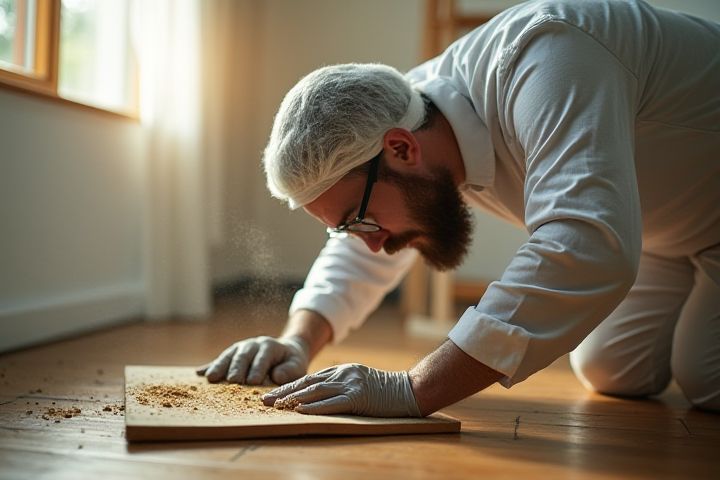
A house typically requires fumigation when there's a serious infestation of pests such as termites, bed bugs, or drywood termites that cannot be effectively controlled through conventional pest control methods. Signs of an infestation may include unexplained wood damage, visible insect activity, or an unusual odor emanating from wooden structures. Fumigation involves enclosing the entire property and applying a gas that penetrates all areas, ensuring complete eradication of pests. This process is usually recommended when other pest treatments have failed or when a property is being prepared for sale and needs to be pest-free to meet buyer expectations. To maintain a pest-free environment in your home, regular inspections and preventive measures are crucial.
When Does A House Need Fumigation
Severe pest infestation.
A house requires fumigation when it experiences a severe pest infestation, particularly with insects like termites or bed bugs, that cannot be effectively managed through traditional treatments. Signs of such infestations may include significant structural damage, visible pests, or an overwhelming presence of droppings. Fumigation is generally recommended when the pest population exceeds a certain threshold, often quantified as hundreds or thousands of individuals. Your home may also benefit from fumigation if over-the-counter solutions have failed, indicating the need for a comprehensive treatment approach to eradicate the pests thoroughly.
Presence of termites.
Fumigation is essential when your house shows clear signs of a termite infestation, such as mud tubes, hollowed-out wood, or discarded wings. Regular inspections by a pest control professional can help detect early termite activity and prevent extensive damage. If you notice a significant population of termites or structural damage, scheduling immediate fumigation is crucial for protecting your property. Staying proactive with treatments can safeguard your home from costly repairs and infestations in the future.
Persistent bed bug problem.
A house requires fumigation when a persistent bed bug infestation is confirmed, typically characterized by visible signs such as bites, blood stains, or shed exoskeletons. If DIY methods fail to eliminate these resilient pests after two to three treatment attempts, professional fumigation becomes necessary. It is crucial to act swiftly, as bed bugs can reproduce rapidly, with females laying up to 500 eggs over their lifetime. Effective fumigation services can eradicate these pests, ensuring your home returns to a safe and comfortable state.
Widespread cockroach invasion.
A house requires fumigation when a widespread cockroach invasion exceeds 15 insects per room, creating a significant health risk. Cockroaches, known for carrying bacteria and allergens, multiply rapidly, with females laying approximately 30 to 40 eggs in one egg case. If you notice physical signs such as droppings, shed skin, or an unusual odor, it's crucial to act quickly. Professional exterminators often recommend fumigation when traditional methods fail, especially for severe infestations persisting over two months.
Large-scale ant colonies.
Large-scale ant colonies often indicate a significant infestation that may require fumigation when their population exceeds several thousands within a structure. If you notice extensive trails, nests in walls, or a sudden surge in activity, these signs suggest an underlying problem that could compromise your home's integrity. Fumigation is most effective when you detect not just foraging ants but also their nests, which may be hidden in cavities or beneath flooring. Prompt action is essential, as leaving the infestation untreated can lead to further damage and an increase in colony size.
Rodent control failure.
A house requires fumigation when rodent control methods have failed, typically evidenced by persistent rodent activity, droppings, gnaw marks, or nesting materials. You might notice these signs in hidden areas such as attics, basements, or behind walls, indicating the need for a more aggressive treatment. Fumigation effectively eradicates not only rodents but also potential pathogens they carry, ensuring safety and hygiene in your home. Timely intervention is crucial, as prolonged infestations can lead to structural damage and health risks for residents.
Structural damage by pests.
A house requires fumigation when there is severe structural damage due to persistent pest infestations, such as termites or carpenter ants. These pests can weaken the integrity of wooden beams, flooring, and furniture, leading to costly repairs and safety hazards. Signs of this damage include visible tunnels, droppings, and hollow-sounding wood, indicating that the pests have compromised the structure. Prompt fumigation can effectively eliminate these invasive species, safeguarding your home from further degradation.
Ineffective traditional pest control.
A house requires fumigation when traditional pest control methods prove ineffective, typically after repeated unsuccessful treatments for infestations of termites, bed bugs, or other pervasive pests. Signs such as considerable structural damage, extensive pest droppings, or an unexpected surge in pest populations indicate the necessity for more aggressive measures. In most cases, if you observe over 5% of wooden structures showing signs of termites, fumigation becomes imperative to prevent further damage. Fumigation is a comprehensive treatment that usually spans 24 to 72 hours, ensuring complete eradication of pests within the treated areas.
Property resale or purchase.
A house typically requires fumigation when it shows signs of severe pest infestations, particularly termites, which can damage structural integrity and significantly impact property value. Home inspectors often recommend fumigation before resale to ensure a pest-free environment, as around 30% of potential buyers are deterred by visible pest issues. If you're contemplating purchasing a property, it's prudent to consider fumigation history; homes treated within the last 5 years generally have better resale potential. Remember that the cost of fumigation, averaging between $1,500 and $2,500, can be a worthwhile investment to enhance your home's marketability and appeal.
Compliance with local regulations.
Fumigation is often required when infestations surpass a specific level, typically when wood-destroying organisms exceed 10% of an area or noticeable activity is present. Local regulations may mandate fumigation for certain pests, such as termites or bed bugs, especially if you plan to sell or rent your property. Compliance with these regulations can involve obtaining a pest control license and scheduling inspections with certified professionals. Ignoring these legal requirements can lead to fines or liability issues, making it crucial to stay informed about local pest management laws.
